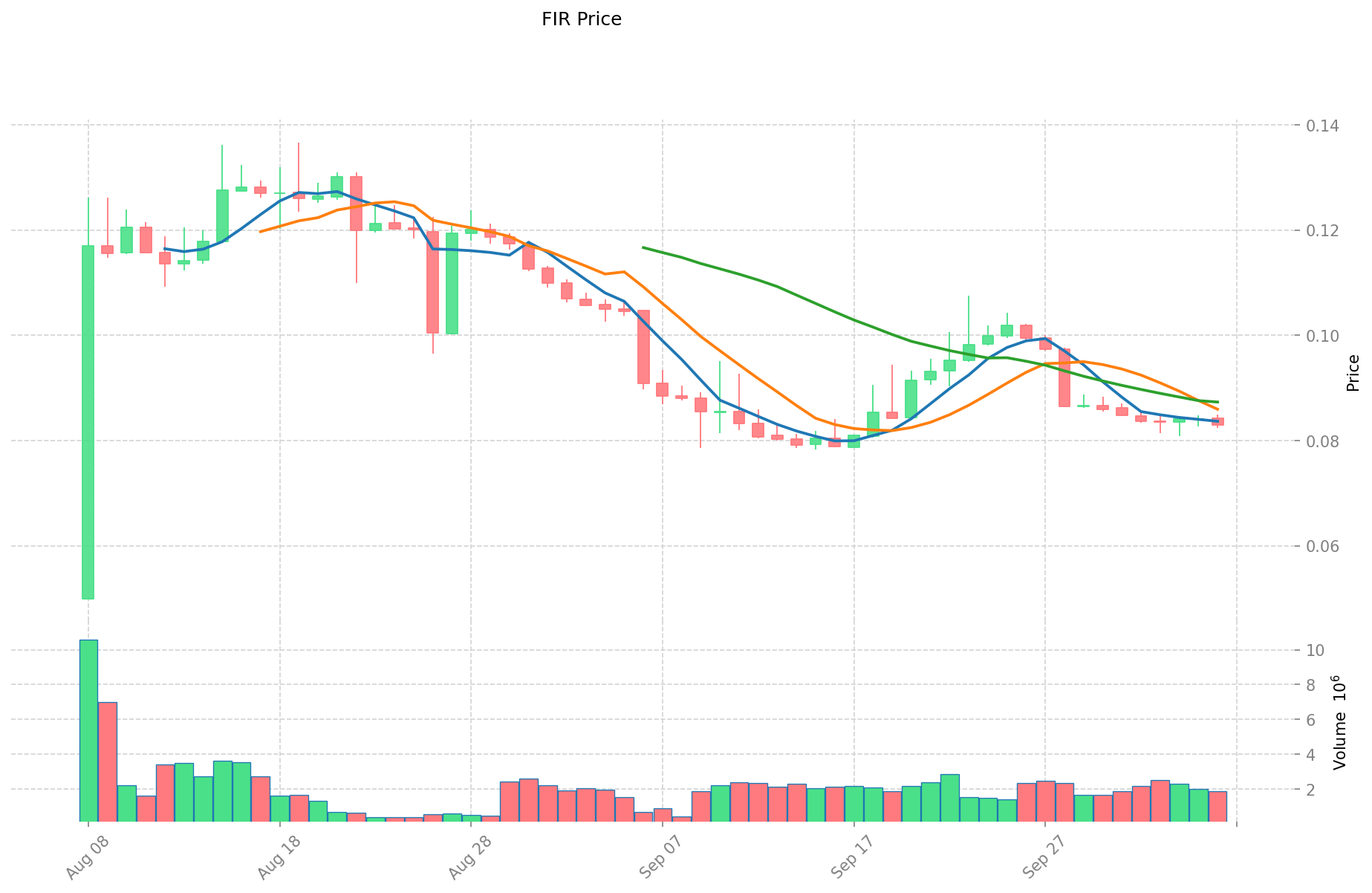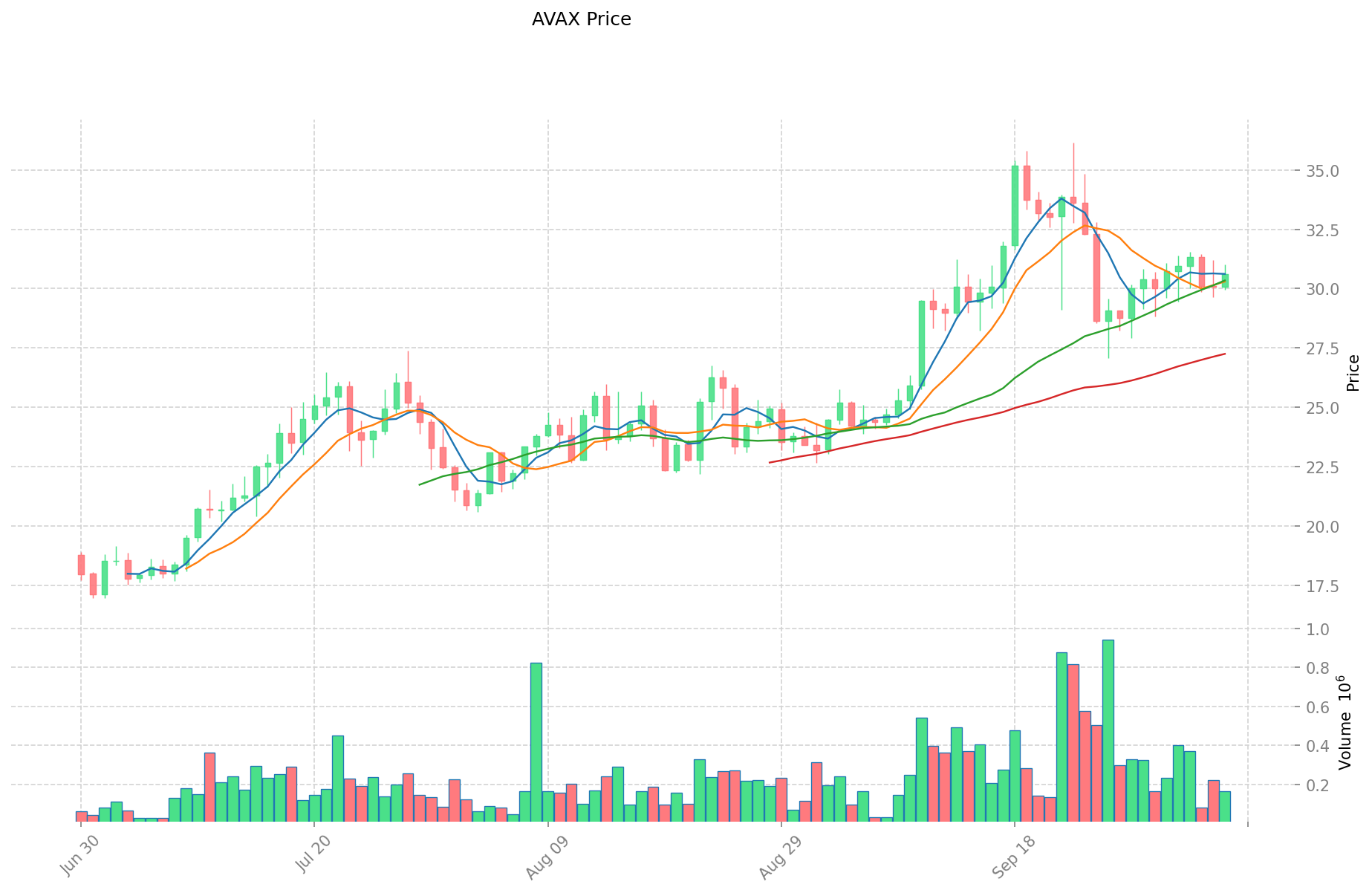FIR vs AVAX: Comparing Two Leading Layer-1 Blockchains in the DeFi Ecosystem
Introduction: Investment Comparison between FIR and AVAX
In the cryptocurrency market, the comparison between Fireverse (FIR) vs Avalanche (AVAX) has always been a topic that investors can't ignore. The two not only have significant differences in market cap ranking, application scenarios, and price performance, but also represent different positioning of crypto assets.
Fireverse (FIR): Since its launch in 2025, it has gained market recognition for its decentralized music creation platform powered by AI and blockchain.
Avalanche (AVAX): Since its introduction in 2020, it has been hailed as a platform for launching decentralized applications and interoperable blockchains, becoming one of the cryptocurrencies with the highest global transaction volume and market capitalization.
This article will comprehensively analyze the investment value comparison between FIR and AVAX, focusing on historical price trends, supply mechanisms, institutional adoption, technological ecosystems, and future predictions, and attempt to answer the question that investors care about most:
"Which is the better buy right now?"
I. Price History Comparison and Current Market Status
FIR and AVAX Historical Price Trends
- 2025: FIR launched on major exchanges, price increased from $0.05 to $0.13.
- 2021: AVAX reached its all-time high of $144.96 due to growing interest in layer-1 blockchains.
- Comparative analysis: In the recent market cycle, FIR dropped from $0.13 to $0.08, while AVAX fell from $144.96 to its current price around $30.
Current Market Situation (2025-10-07)
- FIR current price: $0.08286
- AVAX current price: $30.56
- 24-hour trading volume: FIR $158,378 vs AVAX $4,571,550
- Fear & Greed Index: 71 (Greed)
Click to view real-time prices:
- Check FIR current price Market Price
- Check AVAX current price Market Price


II. Core Factors Affecting AVAX Investment Value
Supply Mechanism (Tokenomics)
- AVAX: Capped supply model with a maximum of 720 million tokens, creating potential scarcity
- 📌 Historical Pattern: Limited supply mechanisms typically support long-term price appreciation during adoption phases.
Institutional Adoption and Market Applications
- Institutional Holdings: AVAX is working toward increased institutional adoption through its $10 billion ecosystem treasury initiative
- Enterprise Adoption: Strategic partnership with Toyota's blockchain laboratory demonstrates growing enterprise interest
- Regulatory Attitudes: AVAX is pursuing regulatory compliance with plans to list AVAT on NASDAQ (stock ticker "AVAT") by Q1 2026
Technical Development and Ecosystem Building
- AVAX Technical Development: High-performance consensus mechanism delivering near-instant finality and thousands of TPS at a fraction of legacy network costs
- Ecosystem: Active DeFi and NFT communities with continual expansion, currently valued at approximately $7 billion market cap as of June 2025
Macroeconomic Factors and Market Cycles
- Inflation Environment Performance: AVAX price movements show correlation with broader market expectations of Federal Reserve policy decisions
- Monetary Policy Impact: Federal Reserve rate cuts have historically provided a positive environment for AVAX price appreciation
- Cross-border Transaction Demand: AVAX's high-speed, low-cost architecture positions it well for cross-border transaction applications
III. 2025-2030 Price Prediction: FIR vs AVAX
Short-term Prediction (2025)
- FIR: Conservative $0.050447 - $0.0827 | Optimistic $0.0827 - $0.094278
- AVAX: Conservative $21.0726 - $30.54 | Optimistic $30.54 - $44.283
Mid-term Prediction (2027)
- FIR may enter a growth phase, with estimated price range $0.0883828132 - $0.1165046174
- AVAX may enter a bullish market, with estimated price range $28.208271 - $51.6428346
- Key drivers: Institutional capital inflow, ETF, ecosystem development
Long-term Prediction (2030)
- FIR: Base scenario $0.0880386585602 - $0.14199783638742 | Optimistic scenario $0.14199783638742 - $0.147677749842916
- AVAX: Base scenario $43.709926700286 - $59.0674685139 | Optimistic scenario $59.0674685139 - $82.103781234321
Disclaimer: This analysis is based on historical data and market projections. Cryptocurrency markets are highly volatile and unpredictable. This information should not be considered as financial advice. Always conduct your own research before making investment decisions.
FIR:
| 年份 | 预测最高价 | 预测平均价格 | 预测最低价 | 涨跌幅 |
|---|---|---|---|---|
| 2025 | 0.094278 | 0.0827 | 0.050447 | 0 |
| 2026 | 0.11238103 | 0.088489 | 0.08229477 | 6 |
| 2027 | 0.1165046174 | 0.100435015 | 0.0883828132 | 21 |
| 2028 | 0.159450629814 | 0.1084698162 | 0.067251286044 | 30 |
| 2029 | 0.15003544976784 | 0.133960223007 | 0.08171573603427 | 61 |
| 2030 | 0.147677749842916 | 0.14199783638742 | 0.0880386585602 | 71 |
AVAX:
| 年份 | 预测最高价 | 预测平均价格 | 预测最低价 | 涨跌幅 |
|---|---|---|---|---|
| 2025 | 44.283 | 30.54 | 21.0726 | 0 |
| 2026 | 49.38318 | 37.4115 | 33.67035 | 21 |
| 2027 | 51.6428346 | 43.39734 | 28.208271 | 41 |
| 2028 | 59.875309998 | 47.5200873 | 34.689663729 | 54 |
| 2029 | 64.4372383788 | 53.697698649 | 45.10606686516 | 74 |
| 2030 | 82.103781234321 | 59.0674685139 | 43.709926700286 | 92 |
IV. Investment Strategy Comparison: FIR vs AVAX
Long-term vs Short-term Investment Strategy
- FIR: Suitable for investors focused on AI and music industry potential
- AVAX: Suitable for investors seeking established ecosystem and institutional adoption
Risk Management and Asset Allocation
- Conservative investors: FIR: 20% vs AVAX: 80%
- Aggressive investors: FIR: 40% vs AVAX: 60%
- Hedging tools: Stablecoin allocation, options, cross-currency portfolio
V. Potential Risk Comparison
Market Risk
- FIR: Limited trading history, potentially higher volatility
- AVAX: Subject to broader crypto market trends and layer-1 competition
Technical Risk
- FIR: Scalability, network stability
- AVAX: Network congestion during peak usage, potential smart contract vulnerabilities
Regulatory Risk
- Global regulatory policies may impact both differently, with AVAX potentially having an advantage due to its pursuit of regulatory compliance
VI. Conclusion: Which Is the Better Buy?
📌 Investment Value Summary:
- FIR advantages: Innovative AI-powered music platform, potential for growth in niche market
- AVAX advantages: Established ecosystem, institutional adoption, regulatory compliance efforts
✅ Investment Advice:
- New investors: Consider a larger allocation to AVAX for its established track record
- Experienced investors: Balanced approach with both FIR and AVAX to capitalize on potential growth and stability
- Institutional investors: Focus on AVAX due to its regulatory compliance efforts and institutional-grade infrastructure
⚠️ Risk Warning: The cryptocurrency market is highly volatile. This article does not constitute investment advice. None
VII. FAQ
Q1: What are the main differences between FIR and AVAX? A: FIR is a newer cryptocurrency focused on AI-powered music creation, while AVAX is an established platform for decentralized applications and interoperable blockchains. AVAX has a larger market cap, higher trading volume, and more institutional adoption.
Q2: Which cryptocurrency has shown better price performance historically? A: AVAX has demonstrated stronger historical price performance, reaching an all-time high of $144.96 in 2021. FIR, being newer, has a more limited price history, moving from $0.05 to $0.13 since its launch in 2025.
Q3: How do the supply mechanisms of FIR and AVAX differ? A: AVAX has a capped supply model with a maximum of 720 million tokens, potentially creating scarcity. FIR's supply mechanism is not specified in the given information.
Q4: What are the key factors affecting AVAX's investment value? A: Key factors include its capped supply model, increasing institutional adoption, strategic partnerships (e.g., with Toyota), regulatory compliance efforts, high-performance consensus mechanism, and active DeFi and NFT ecosystems.
Q5: How do the long-term price predictions for FIR and AVAX compare? A: By 2030, FIR is predicted to reach $0.0880386585602 - $0.147677749842916, while AVAX is expected to reach $43.709926700286 - $82.103781234321, suggesting potentially higher returns for AVAX.
Q6: What are the recommended investment strategies for FIR and AVAX? A: Conservative investors might allocate 20% to FIR and 80% to AVAX, while aggressive investors might consider 40% FIR and 60% AVAX. AVAX is generally recommended for new and institutional investors due to its established ecosystem and regulatory compliance efforts.
Q7: What are the main risks associated with investing in FIR and AVAX? A: Both face market risks related to crypto volatility. FIR has limited trading history and potential technical risks. AVAX faces competition from other layer-1 platforms and potential network congestion. Both are subject to evolving regulatory environments, though AVAX may have an advantage due to its compliance efforts.
Share
Content